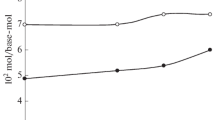Abstract
Thermogravimetry was used to investigate the effects of different inorganic functional fillers on the heat resistance of polymer matrices. The kinetic parameters of thermal oxidative degradation were shown to depend on the polymer, the chemical composition of the filler surface, the filler concentration, and the processing method, which determines the distribution of filler particles in the polymer matrix. Magnetic fillers (carbonyl iron, and hexaferrites of different structural types) were shown to be chemically active fillers, increasing the heat resistance of siliconorganic polymers. Their stabilizing effect is due to blocking of the end silanol groups and macroradicals by the surface of the filler and non-chain inhibition of thermal oxidative degradation. In the case of fiber-forming polymers (UHMWPE, PVOH and PAN), most magnetic fillers are chemically inert, but at concentrations of 30–50 vol% they increase the heat resistance of the composite. Addition of carbon black increased the heat resistance of the thermoplastic matrix. The dependence of the thermal degradation onset temperature on the kaolin concentration in the polyolefin matrix exhibited a maximum. Analysis of the experimental results demonstrated the operating temperature ranges for different composites, and their maximum operating temperature.
Similar content being viewed by others
References
T. Takagi, In: Proc. of the 3rd Int. Conf. Intelligent Materials, Lyon, 3–5 June 1996, SPIE 2779, p. 2.
A. T. Ponomarenko, A. V. Buts, V. G. Shevchenko and C. Klason, Proc. 1994 North American Conf. on Smart Structures and Materials, SPIE, 2191, 1994, 399.
F. Gubbels, R. Jérôme, Ph. Teyssié, E. Vanlathem, R. Deltour, A. Calderone, V. Parenté and J. L. Brėdas, Macromolecules, 27 (1994) 1972.
F. Gubbels, S. Blacher, E. Vanlathem, R. Jérôme, R. Deltour, F. Brouers and Ph. Teyssié, Macromolecules, 28 (1995) 1559.
F. Hindryckx, P. Dubois, R. Jérôme, P. Teyssié and M. G. Marti, J. Appl. Polym. Sci., 64 (1997) 423 and 439.
Y. Kamiya and E. Niki, In: Aspects of Degradation and Stabilization of Polymers (Ed. H. H. G. Jellinek), Elsevier, Amsterdam 1978. p. 80.
T. Atkins and C. Batich, MRS Bulletin, 18 (1993) 40.
W. Schnabel, Polymer Degradation: Principles and Practical Applications, Macmillan, New York 1981.
M. Amin and A. Maadhah, In: Handbook of Polymer Degradation (Ed. S. H. Hamid), Marcel Dekker, New York 1992.
Author information
Authors and Affiliations
Rights and permissions
About this article
Cite this article
Ponomarenko, A.T., Klason, C., Kazantseva, N.E. et al. Thermogravimetry as a Method for Investigating the Thermal Stability of Polymer Composites. Journal of Thermal Analysis and Calorimetry 55, 537–549 (1999). https://doi.org/10.1023/A:1010102104489
Issue Date:
DOI: https://doi.org/10.1023/A:1010102104489




